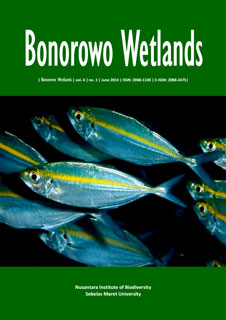The diversity of macrozoobenthos in silvofishery mangrove and natural mangrove ecosystems in the Boe Coast Ecotourism Area, Takalar District, South Sulawesi
##plugins.themes.bootstrap3.article.main##
Abstract
Abstract. Marpaung AAF, Yasir I, Ukkas M. 2014. The diversity of macrozoobenthos in silvofishery mangrove and natural mangrove ecosystems in the Boe Coast Ecotourism Area, Takalar District, South Sulawesi. Bonorowo Wetlands 4: 1-11. This study was conducted to determine the diversity of macrozoobenthos in mangrove silvofishery and natural mangroves ecosystems and to compare the abundance of macrozoobenthos in the two different ecosystems. The study was conducted between December 2012 and February 2013, located in the Mappakalompo Village pond and the estuary area of the Boe Beach Ecotourism Area, Galesong Subdistrict Takalar District, South Sulawesi. Observations were made on two stations, namely mangrove silvofishery and natural mangroves. The research method is the survey and sampling methods, then analyzed in a laboratory. The results show that the diversity of macrozoobenthos in both ecosystems is 16 species, in mangrove silvofishery found 5 species divided into 3 species of Gastropoda, 1 species of Bivalvia, and 1 species of Maxillopoda; whereas in natural mangroves found 15 species consisting of 6 species of Gastropoda, 7 species of Bivalvia, 1 species of Maxillopoda and 1 species of crustacea. Cerithidea cingulata is the most dominant macrozoobenthos. For macrozoobenthos, silvofishery mangrove ecosystems have high macrozoobenthos abundance (1219/m²), but species diversity is low. Meanwhile, natural mangrove ecosystems have small macrozoobenthos abundance (730/m²), but species are more diverse. For mangroves, the natural mangrove ecosystem is more diverse with four species, namely Avicennia sp., Bruguiera sp., Rhizophora mucronata, and Rhizophora stylosa. While, mangrove silvofishery only overgrew two species, namely R. mucronata and R. stylosa, both planted by pond farmers.

